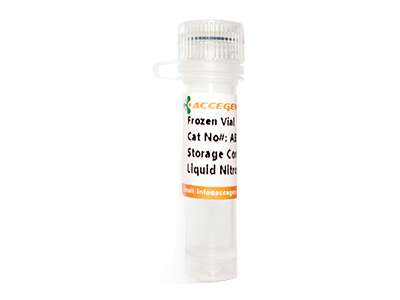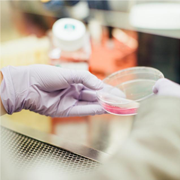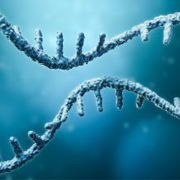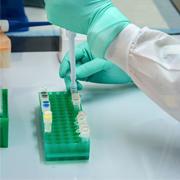Home > Products > Tumor Cell Lines > Human Tumor Cell Lines >
T3M-4 |
||||
|---|---|---|---|---|
| Product Name |
T3M-4 |
|||
| Price | Get Quote | |||
| Product Code | T3M4; Panc89; Panc-89; PANC-89; Panc 89 |
|||
| Cat.No |
ABC-TC1324 |
Species |
Human |
|
| Size/Quantity |
1 vial |
Biosafety Level |
1 |
|
| Shipping Info |
Dry Ice |
Storage |
Liquid Nitrogen |
|
| Description |
T3M-4 cells are a human carcinoembryonic antigen (CEA)-producing cell line derived from a primary human pancreatic exocrine adenocarcinoma transplanted into nude mice. These cells exhibit epithelial features similar to the original tumor and grow as a monolayered sheet with a population doubling time of about 31 hours. They demonstrate tumorigenicity in athymic nude mice and maintain their original histology through serial transplantation. The cell line is a human aneuploid one with a hyperdiploid mode, as confirmed by chromosomal analysis. T3M-4 cells secrete CEA both in vitro and in vivo when used to generate tumors in nude mice.
T3M-4 cells from AcceGen are an excellent choice due to their high viability, sterile nature, and optimal incubation and cryopreservation conditions using advanced techniques. These cells undergo rigorous quality control measures and are safely transported, ensuring reliable and consistent performance for research and experimentation purposes. |
|||
| Citation Guide |
When you publish your research, please cite our product as “AcceGen Biotech Cat.# XXX-0000”. In return, we’ll give you a $100 coupon. Simply click here and submit your paper’s PubMed ID (PMID). |
|||
| Application | FOR RESEARCH USE ONLY The T3M-4 cell line has several valuable applications in the field of human pancreatic cancer research. Firstly, it can be used to identify the gene profile of human pancreas carcinoma, enabling the analysis of oncogene activation as well as aberrant expression and epigenetic changes of genes specific to pancreatic cancer. This aids in understanding the molecular mechanisms underlying the disease. Additionally, T3M-4 cells serve as a useful tool for evaluating the anti-tumor potential of antibodies or drugs, facilitating the development of novel therapeutic strategies for treating human pancreatic cancer. By assessing the efficacy of different treatments, researchers can advance the search for effective therapies targeting this challenging malignancy. |
|||
| Growth Conditions | 37 ℃, 5% CO2 |
|||
| Product Type |
Human Pancreas Cancer Cell Lines |
|||
| Product Image |

|
|||
Frequently Asked Questions
-
What is the recommended seeding density for T3M-4 cells?
Approximately 1-2 ×10^4 cells/cm².
-
Why are T3M4 cells forming clumps and not attaching after subculturing with trypsin?
Insufficient Trypsinization: The cells may not have been trypsinized long enough, leading to incomplete detachment and clumping.
Excessive Trypsinization: Prolonged exposure to trypsin can damage cell surface proteins, affecting their ability to reattach.
Incorrect Trypsin Concentration: Using a trypsin solution that is too concentrated can harm the cells, while too dilute may not be effective.
Incomplete Neutralization of Trypsin: If trypsin is not completely neutralized with serum-containing medium after detachment, residual trypsin can continue to damage cells.
Cell Density: Plating cells at too high or too low a density can affect their ability to attach and spread out.
Suboptimal Culture Conditions: Temperature, pH, or medium composition might not be optimal for cell attachment.
-
What to do when T3M-4 cells form clumps and do not adhere to the wall after trypsin subculture?
Optimize Trypsinization Time: Ensure cells are exposed to trypsin-EDTA for an appropriate duration (usually 2-5 minutes at 37°C) to detach without excessive damage. Monitor under a microscope.
Neutralize Trypsin Effectively: Immediately add an appropriate amount of medium containing serum to neutralize the trypsin after detachment.
Use Gentle Pipetting: Gently pipette the cells up and down to break up clumps without causing excessive mechanical damage.
Optimize Seeding Density: Seed cells at an appropriate density (e.g., 1-2 x 10^4 cells/cm²) to allow for optimal attachment and growth.
Check Culture Conditions: Ensure the culture medium is pre-warmed to 37°C and that the CO₂ levels and pH are appropriate.
Coating Culture Vessels: If cells still do not attach well, consider coating the culture vessels with extracellular matrix proteins (e.g., collagen, fibronectin) to enhance cell adhesion.
- ONLINE INQUIRY
- PRODUCT REVIEWS
Fill out a request in the form below and we’ll get back to you within 24 hours with a quote.






 Why choose T3M-4 from AcceGen?
Why choose T3M-4 from AcceGen?